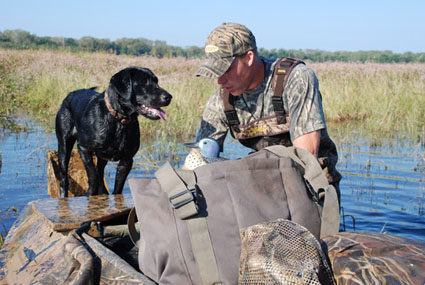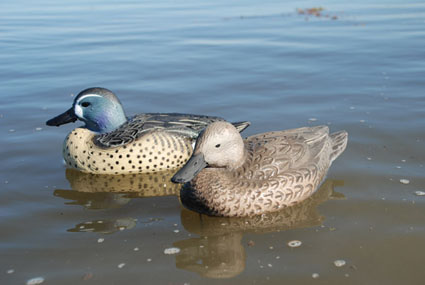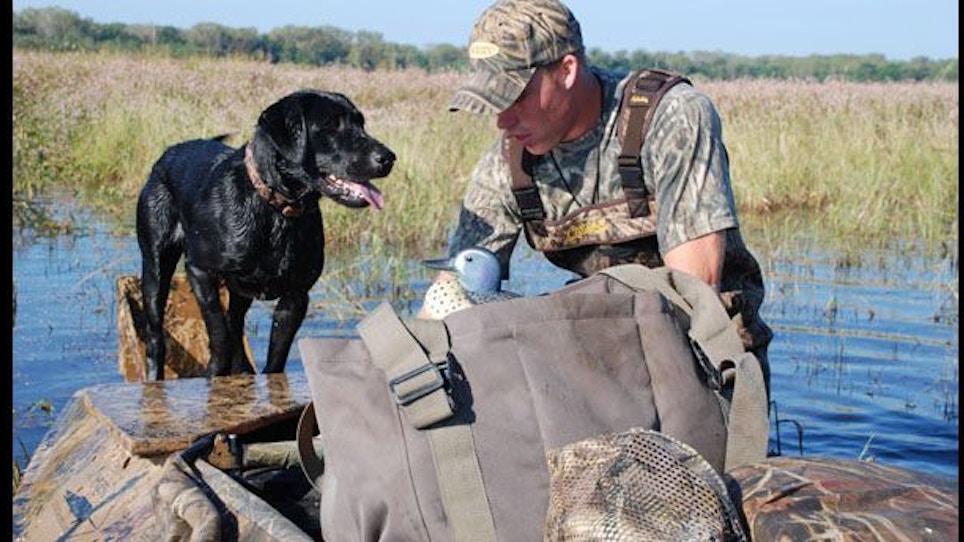 When I started hunting teal in Ohio in the mid-1970s, my father and I used neither decoys nor calls. We simply waded out into Elmer Simmons’ swamp, stood among the cattails in our Vietnam-era Woodland camouflage t-shirts, and shot teal. Actually, the Old Man shot teal; I shot at teal. Were we successful? Occasionally, yes. Could we have been more successful had we used all the tools at our disposal? Undeniably, yes.
When I started hunting teal in Ohio in the mid-1970s, my father and I used neither decoys nor calls. We simply waded out into Elmer Simmons’ swamp, stood among the cattails in our Vietnam-era Woodland camouflage t-shirts, and shot teal. Actually, the Old Man shot teal; I shot at teal. Were we successful? Occasionally, yes. Could we have been more successful had we used all the tools at our disposal? Undeniably, yes.
“The first thing that people need to understand is that teal aren’t dumb,” says Travis Mueller. A territory manager for Avery Outdoors (averyoutdoors.com), Mueller, at 35, is a tactical wizard when it comes to waterfowl. “None of these species are dumb. Teal are creatures of habit, but there’s a reason for what they do and what they don’t do. Just because there’s a so-called method to their madness doesn’t make them dumb. Naïve, especially the first few days? Sure, but they get smart just like the rest of them.”
So, then, if teal are intellectually equivalent to any other species, shouldn’t the same importance be given teal decoys as is given, say, a mallard spread or a canvasback rig? Or are decoys really necessary when the only game in town is teal?
“I think that (teal) decoys are definitely important,” says Mueller. “Teal migrate together, and often in large flocks, so it’s natural for them to see flocks of teal on the water when they’re looking for a place to sit down. Especially if they’re migrants. And today,” he continues, “it’s all about natural decoys. It’s all about realism. When you’re trying to attract birds to a place you’ve hunted five or six days in a row, enough can’t be said about realistic decoys.”
On-the-water motion, too, says Mueller, can be a vital ingredient in creating a successful teal hunt. “I’d much rather be limited to five decoys with some type of motion on the water than be told I could use 200 decoys but no movement whatsoever,” he says. As for teal? Yeah, they’ll often fly right on the deck. And they won’t often circle and circle, looking things over like mallards, but they’ll still catch things. That splashing on the water — a jerk cord, let’s say — can make all the difference.”
Which brings us to this question — Is it vital to use teal decoys when specifically targeting teal? Or will the traditional dozen mallards — Yes, we’ll all done it — work just fine, thank you very much? “I see teal finish better over teal decoys,” says Missourian Tony Vandemore. A talented waterfowler and accomplished dog trainer, Vandemore was my host for a September teal extravaganza in the Show Me State. “Your shot opportunities,” he continues, “are going to be better when you use teal decoys. And that’s especially important if you’re working with young, maybe somewhat inexperienced hunters. You’re going to gain something visually, too, when you use the (colorful) blue-wing decoys.”
 Vandemore goes on to comment on the ease with which teal decoys can be put into play. “They’re very lightweight, so it’s no problem to throw a dozen or two over your shoulder. And because of where we’re using them (NOTE — Typical scenario is six to 16 inches of water, with submergent and emergent vegetation), we’ll often either not unwrap the anchor, or we’ll replace the (heavier) anchors with a J-shaped piece of copper wire.”
Vandemore goes on to comment on the ease with which teal decoys can be put into play. “They’re very lightweight, so it’s no problem to throw a dozen or two over your shoulder. And because of where we’re using them (NOTE — Typical scenario is six to 16 inches of water, with submergent and emergent vegetation), we’ll often either not unwrap the anchor, or we’ll replace the (heavier) anchors with a J-shaped piece of copper wire.”
If you’re not willing to part with about $20 for six Greenhead Gear blue-wing decoys, will mallard decoys fill the void? Personally speaking, I’ve killed more than one limit of blue-wings and green-wings over mallard blocks, and this from September through the close of Washington state’s duck season in late January. So, yes, it can be done; however, Vandemore does make a good point for those who would choose to stick with their mallards even when the menu reads teal. “We’ve always used hen (mallard) decoys when we teal hunt,” the young man says. “A lot of birds are drab — brown drab — that time (September) of year, so we used the hens to make things look more natural. Now, though, I’m using teal decoys. To me, it doesn’t matter if you’re hunting greenheads, geese or teal — there’s no sense in doing something if you’re going to be sloppy.”
Do I Need A Teal Call?
Yes, Virginia, there are indeed teal-specific calls; however, the question here is a simple one — are they necessary? Necessary? Probably not. Effective? Without a doubt. Many times, I’ve watched a flock of blue-wings double back over itself in response to the quick, high-pitched QUACK..qua-qua-qua-qua-qua of a teal-specific call. Or in some cases, a talented hand blowing a high-tuned traditional single-reed mallard hen call. Regardless of the instrument, the key to calling blue-wings is to (1) try it, and (2) think pitch and stepped-up cadence. PRIMOS Hunting Calls (primos.com) offers a wonderful little teal call, complete with an instructional CD, that makes calling these little ducks as easy as listen and learn.
Although hen green-wings (GWT) do quack — again, think high-pitch and fast, ala blue-wings — I’ve found GWTs perhaps respond better to short whistles and peeps, particularly to a loud peep…peep-peep…peep-peep sequence. Several call-makers have multi-species whistles that duplicate not only GWTs, but pintails, widgeon, drake mallards and, for you turkey hunters, the screams of a red-tailed hawk.
With the exception, perhaps, of mourning doves, teal are without question the most challenging winged quarry I’ve ever had the pleasure of pursuing. They’re ridiculously quick in flight, abundant across all four flyways, receptive to decoy spreads and calling, and, my favorite qualifier, absolutely without equal on the table. So no offense, Mister Mallard Purist; greenheads are good, but green-wings? Well, sir, you know what Tony the Tiger says — They’re GREAT!






